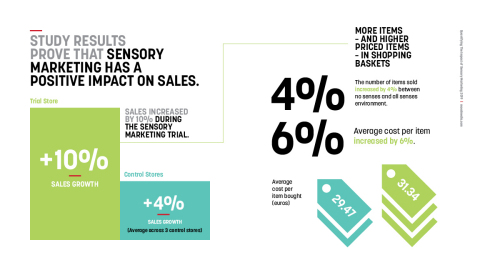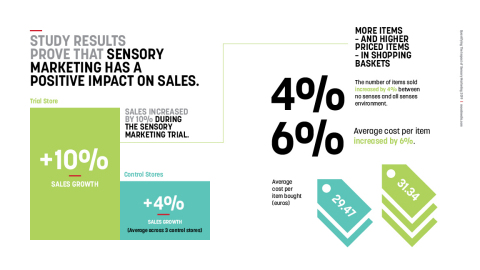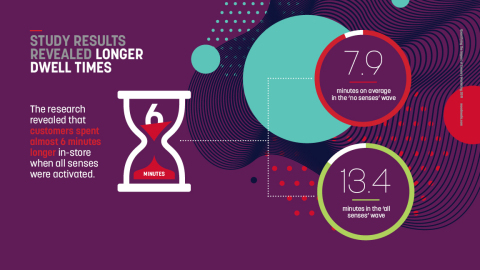AUSTIN, Texas--(BUSINESS WIRE)--Mood Media, the world’s leading in-store media solutions company dedicated to elevating the Customer Experience, today released a new quantitative behavioral marketing study, “Quantifying the Impact of Sensory Marketing,” which proves that sensory marketing has positive emotional, cognitive and behavioral impacts on shoppers in-store. In this study, Mood Media partnered with its international sports retailer client, INTERSPORT, to conduct a controlled experiment that found when sensory marketing was applied, sales increased by 10 percent. Also highly noteworthy, shoppers spent almost six minutes longer in-store when the senses were activated.
“Knowing that 78% of shoppers say an enjoyable atmosphere plays a key factor in purchasing a product in-store versus online, we partnered with Walnut Unlimited to develop unique behavioral and neuromarketing quantitative research that demonstrates how shoppers react first-hand to specific sensory experiences,” said Scott Moore, Global CMO of Mood Media. “The results speak for themselves. A strategic top-level approach to incorporating in-store sensorial elements creates a measurable emotional response with consumers that delivers bottom-line results.”
Additional key findings showcasing the positive impact of in-store sensorial stimuli include:
- Shoppers purchased more items (increase of 4 percent) - and higher priced items (increase of 6 percent in value) - when sensorial marketing elements were in place.
- The use of scent is even more impactful when being used to highlight a specific department or zone. In the scented football zone, customers’ emotional levels were elevated by 28 percent compared to the baseline.
- From the installation of scent in the football area to-date, INTERSPORT has noticed a 26 percent increase in sales in the category in the test store compared to the same category performance in all the other stores throughout the country.
- Based on Eye Tracking (ET) metrics, awareness of digital screens in-store increased by 5 percent when moving visualizations were activated on-screen (vs. static images).
- Based on Galvanic Skin Response (GSR) metrics, a lack of sensorial elements in-store caused many consumers to become awkwardly self-aware while shopping, with 17 percent becoming more emotionally sensitive and uncomfortable in an unusually quiet and stimulant-free environment.
- Consumers like seeing themselves, which the study describes as “the science of narcissism.” Galvanic Skin Response (GSR) and Eye Tracking (ET) metrics showed a significant increase in nervous system activity and engagement when consumers saw themselves in mirrors and interacted with products in front of mirrors.
- Shoppers showed a 50 percent emotional increase when touching and engaging with a product. This supports first-hand the important and unique role that in-store shopping continues to serve.
“As we build our omnichannel strategy, we continue to focus on enhancing our brick & mortar stores with memorable and engaging experiences that connect with our customer base,” said Chris Kleine, Director Design and Development from IIC-INTERSPORT Intl Corp. “The involvement of our national licensee in this research has further highlighted how important sensory experiences are in creating a positive in-store environment that brings shoppers back time and time again.”
Our Methodology:
In order to understand how INTERSPORT shoppers reacted to sensory experiences, Mood Media set up an environment which was split into two phases in a store in Amsterdam. One was an “all senses” phase where all the sensory elements were activated, including music, the scent of fresh-cut grass and animated digital signage. The other was a “no senses” phase where the store lacked all sensory elements. These results were then compared to three INTERSPORT “control stores” which remained unchanged from their normal environment. To measure the emotional impact of the sensory marketing and to gain insights into the different consumer behavioral and cognitive responses, Walnut Unlimited measured Galvanic Skin Responses (GSR) and Visual Eye Tracking (ET).
To download the booklet to view more comprehensive study results, visit: https://us.moodmedia.com/sensory-marketing/.
About Mood Media
Mood Media is the world’s leading in-store media solutions company dedicated to elevating the Customer Experience. Mood creates greater emotional connections between brands and consumers through the right combination of sight, sound, scent, social mobile and systems solutions. Mood reaches more than 150 million consumers each day through more than 500,000 subscriber locations in 100+ countries around the globe. Mood’s clients include businesses of all sizes and market sectors, from the world’s most recognized retailers and hotels to quick-service restaurants, local banks and thousands of small businesses. For more details: www.moodmedia.com.
About Walnut Unlimited
Walnut Unlimited is a more than a market research agency, they are the human understanding agency. They uncover human insights that help bring global brands closer to understanding people for better business decisions. Through innovative thinking, they use no-nonsense science drawing on specialisms in neuroscience and behavioral psychology and economics. They work across retail and customer experience, technology, financial, FMCG, brand and communications. Information about Walnut Unlimited can be found here: www.walnutunlimited.com.
About INTERSPORT and The Athlete’s Foot
With retail sales of EUR 11.6 billion in 2018 and more than 5,500 affiliated stores in 43 countries, INTERSPORT is one of the world's leading sporting goods retailers. In December 2012, INTERSPORT acquired the athletic specialty footwear chain, The Athlete's Foot, with 550 stores in 30 countries and retail sales of EUR 363 million in 2018. In total, the INTERSPORT Group has a turnover of EUR 11.9 billion and is represented in 57 countries on all five continents (www.intersport.com).





